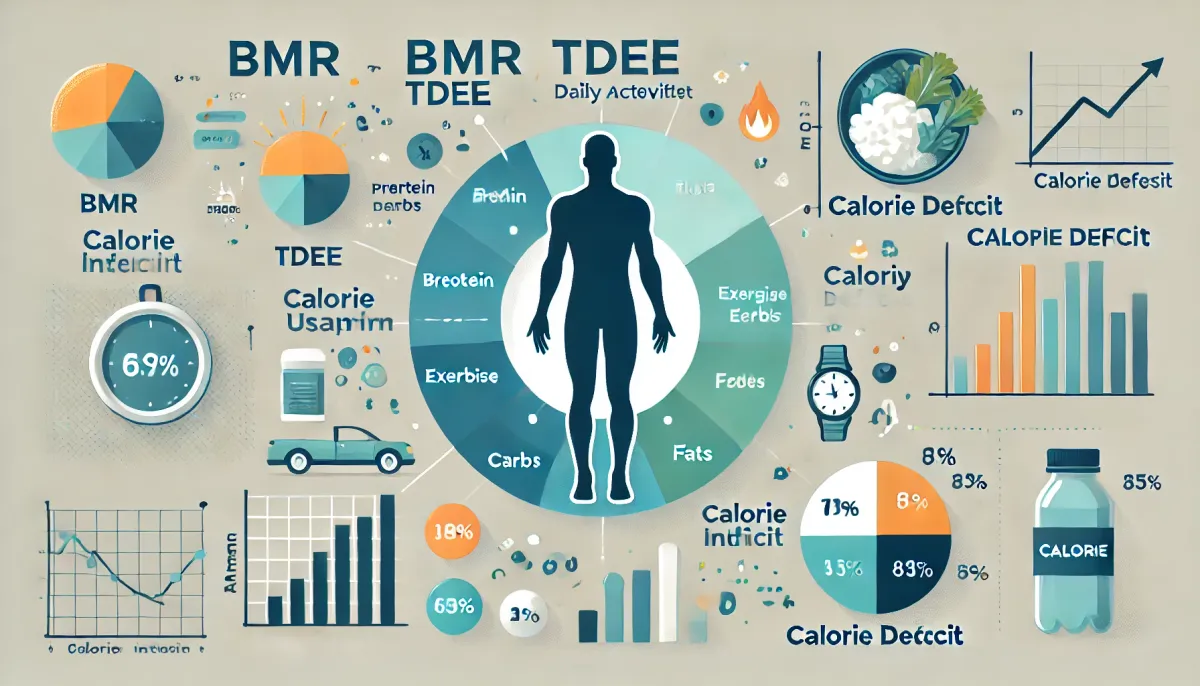BMR, TDEE, and Calorie Deficit: A Comprehensive Guide with Examples and Tips

Achieving successful weight loss is not just about restricting food intake but understanding fundamental concepts such as BMR, TDEE, and Calorie Deficit. This guide explains these concepts with examples and practical advice to help calorie-counting enthusiasts achieve effective results.
What is BMR?
BMR (Basal Metabolic Rate) is the amount of energy your body requires to perform basic life-sustaining functions such as breathing, heart activity, and maintaining body temperature. It excludes energy spent on physical activities.
BMR Calculation Formula (Mifflin-St Jeor):
- Men: BMR = (10 x weight in kg) + (6.25 x height in cm) - (5 x age) + 5
- Women: BMR = (10 x weight in kg) + (6.25 x height in cm) - (5 x age) - 161
Example Calculation:
- Female, 60 kg, 165 cm, 30 years old: BMR = (10 x 60) + (6.25 x 165) - (5 x 30) - 161 = 600 + 1031.25 - 150 - 161 = 1320.25 kcal
What is TDEE?
TDEE (Total Daily Energy Expenditure) is the total energy your body uses in a day, including physical activity.
How to Calculate TDEE: TDEE = BMR x Activity Factor
Activity Factors:
- Sedentary (little or no exercise) = 1.2
- Light activity (1-3 days/week) = 1.375
- Moderate activity (3-5 days/week) = 1.55
- Heavy activity (6-7 days/week) = 1.725
The Role of Body Fat Percentage in TDEE: Body fat percentage can refine BMR and TDEE calculations, as muscle mass burns more calories than fat, even at rest. Individuals with higher muscle mass and lower body fat typically have a higher BMR and TDEE.
Formula Incorporating Body Fat (Katch-McArdle):
- Calculate Lean Body Mass (LBM): LBM = weight in kg x (1 - body fat percentage/100)
- BMR = 370 + (21.6 x LBM)
Example:
- Weight: 70 kg, Body Fat: 20% LBM = 70 x (1 - 0.20) = 56 kg BMR = 370 + (21.6 x 56) = 370 + 1209.6 = 1579.6 kcal
Example TDEE Calculation:
- BMR = 1579.6 kcal Moderate activity (1.55): TDEE = 1579.6 x 1.55 = 2448.38 kcal
What is Calorie Deficit?
A calorie deficit is achieved when you consume fewer calories than your TDEE, forcing your body to use stored fat for energy. It is a proven, safe approach to weight loss.
Example:
- TDEE = 2448.38 kcal To lose 0.5 kg/week (~3500 kcal deficit/week): Daily deficit = 500 kcal Target intake = 2448.38 - 500 = 1948.38 kcal
Steps to Track and Adjust Calorie Intake
- Monitor and Record Calorie Intake: Before starting, assess your daily energy expenditure to understand your body's energy usage. For example, if your TDEE is calculated to be 2000 kcal per day, spend two weeks observing weight changes and dietary habits. Record every calorie consumed with precision using tools like food scales and apps. Weigh yourself each morning to calculate an average for the week, which helps refine your TDEE.
For instance, during the first week, if you eat an average of 2000 kcal daily and gain 0.5 kg, it suggests you consumed a weekly surplus of 3500 kcal, or approximately 500 kcal more than needed each day. This implies your actual expenditure is closer to 1500 kcal per day.
In the second week, reduce intake to 1500 kcal and observe the changes. If weight stabilizes, it confirms your TDEE is 1500 kcal. This adjustment process reflects how the body adapts its metabolism to match lifestyle changes. For example, prolonged lower calorie intake or reduced activity can slow metabolism, making long-term weight loss challenging without modifying habits.
To address discrepancies in BMR and TDEE, consider increasing physical activities, like resistance training, to build muscle and boost metabolism. Also, incorporate daily movement like walking to stimulate energy use consistently.
Eliminating sugar and sweets can further refine energy balance since sugar contributes more significantly to fat storage than excess calories alone. Removing these allows for more accurate tracking of effective calorie intake and portion sizes. Use tools like food scales and apps for accuracy. Weigh yourself daily and calculate weekly weight changes to refine your TDEE estimate.
- Adjust Calories Based on Results: If weight increases, you are in a surplus. If weight remains stable, you are at maintenance. Adjust intake by 300-500 kcal for a deficit.
Practical Weight Loss Tips with Calorie Counting
1. Set Realistic Goals
Use your BMR and TDEE to set a suitable calorie target. Avoid drastic deficits to maintain energy and prevent muscle loss.
2. Focus on Nutrient-Dense Foods
- Protein (20-30%): Chicken, fish, eggs, tofu.
- Carbs (40-50%): Whole grains, sweet potatoes, oats.
- Fats (20-30%): Avocado, nuts, olive oil.
- Vegetables and Fruits: Ensure fiber and vitamins in every meal.
3. Utilize Tracking Tools
Apps like MyFitnessPal help monitor intake and evaluate trends.
4. Incorporate Exercise
Combine cardio and resistance training to boost TDEE and preserve muscle.
5. Adopt Healthy Habits
- Eat regularly; avoid skipping meals.
- Opt for filling foods like proteins and high-fiber options.
- Limit high-calorie, low-nutrient items (e.g., sugary snacks).
Conclusion
Understanding BMR, TDEE, and calorie deficits provides the foundation for sustainable weight loss. Combine this knowledge with balanced nutrition, regular exercise, and a consistent routine to achieve your goals.
Checklist to Begin:
- Calculate your BMR and TDEE.
- Set a suitable calorie intake.
- Plan meals based on nutrient ratios.
- Monitor progress and adjust accordingly.
Ready to embark on your weight loss journey? Share your goals and experiences below!
You can use this calculator here
https://en.fiftygofit.com/bmr-tdee-calculator/



